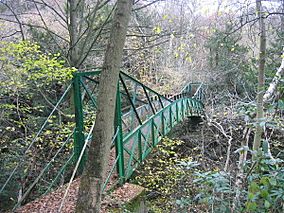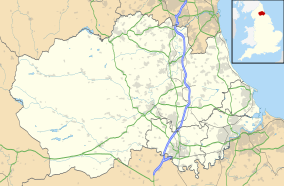Castle Eden Dene facts for kids
Quick facts for kids Castle Eden Dene |
|
|---|---|

Gunners Pool Bridge in Castle Eden Dene
|
|
| Location | Easington, North East, England |
| Area | 192.97 ha (476.8 acres) |
| Established | 1984 (SSSI) |
| Governing body | Natural England |
| Website | Map of site |
Castle Eden Dene is a special natural area in County Durham, England. It is found mostly in Peterlee, between the A19 and A1086 roads. This amazing place is known as a Site of Special Scientific Interest (SSSI) and a National Nature Reserve. This means it is protected because of its unique plants, animals, and geology.
The dene is a deep, narrow valley formed by a stream flowing into the North Sea. It's the biggest and most diverse of its kind in the area. The valley sides are very steep, making it hard for people to reach some parts. This has helped keep the area wild and untouched for a long time.
Contents
What is Castle Eden Dene?
Castle Eden Dene is a large area of natural woodland in north-east England. It's like a huge outdoor classroom where you can learn about nature. The word "dene" means a deep, wooded valley. This one was carved out over thousands of years by streams. These streams cut through layers of rock called Magnesian Limestone and boulder clay.
Why is it Special?
Castle Eden Dene is special for many reasons. It's one of the best examples of ancient woodland in the region. This means the trees and plants here have been growing for a very long time, even before medieval times. Because it's so steep, much of the dene has remained undisturbed by humans. This has allowed many rare plants and animals to thrive.
Trees and Plants of the Dene
The woodland in Castle Eden Dene is home to many different types of trees. You'll mostly see ash trees, like the Fraxinus excelsior, and wych elm trees, Ulmus glabra. Sycamore trees, Acer pseudoplatanus, are also common. You might also spot many yew trees, Taxus baccata.
The Name "Eden"
The name "Eden" might come from the yew trees. Some people think "Eden" comes from an older name, "Yoden," which means Yew dene (a valley with yew trees). Another idea is that "Eden" comes from an old word meaning "a spring" or "water."
Amazing Plant Life
Over 450 different types of plants have been found in Castle Eden Dene. Many of these plants are very old and special.
- Wild Garlic: In spring, you'll smell wild garlic, also called ramsons (Allium ursinum). Its leaves cover the ground.
- Common Plants: Other common plants include dog's mercury (Mercurialis perennis) and sanicle (Sanicula europaea).
- Rare Flowers: Look out for rare flowers like lily-of-the-valley (Convallaria majalis), herb paris (Paris quadrifolia), and the bird's-nest orchid (Neottia nidus-avis).
- Spring Blooms: In early spring, the ground is covered with yellow primroses (Primula vulgaris) and lesser celandine (Ranunculus ficaria). White wood anemones (Anemone nemorosa) also bloom.
- Bluebell Carpets: Later in spring, thick carpets of bluebells (Hyacinthoides non-scripta) appear. They make the woodland floor look like a purple-blue sea.
Exploring Castle Eden Dene
Castle Eden Dene is a great place for walkers and nature lovers. There are many ways to enter the dene. You can come from Peterlee and Horden in the north. You can also enter from Castle Eden, Blackhall, and Heselden in the south. The A19 and A1086 roads also have access points.
Keeping Paths Safe
Natural England helps manage the dene with local councils. They work hard to make the paths and bridges safe for visitors. They strengthen paths and improve drainage. However, very heavy rain can sometimes make parts of the dene hard to access. Sometimes, paths might even need to be closed for safety.
Important Rules for Visitors
To keep the dene safe and protect its plants, there are a few rules:
- Always stay on the marked paths. This helps prevent accidents and protects the delicate plants.
- Bicycles are not allowed inside the reserve. This helps keep the paths clear and safe for walkers.
Following these rules helps everyone enjoy this beautiful natural reserve.
Images for kids




